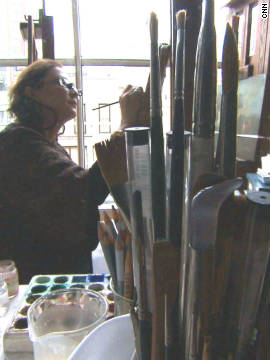>>> This press release can be found on our website at http://bit.ly/crcpress <<<

FOR IMMEDIATE RELEASE
March 21, 2013
Contact: Eric Pourchot
Phone: (202) 661-8061
Email: epourchot@conservation-us.org
Foundation Supports Ongoing Care of Collections After Devastation of Superstorm Sandy
WASHINGTON, D.C. — The Foundation of the American Institute for Conservation of Historic and Artistic Works (FAIC) has completed work at the Cultural Recovery Center (CRC) in Brooklyn, NY after serving a community of artists and organizations in dire need of assistance. The CRC offered space and help at no cost to owners of artworks damaged as a result of Superstorm Sandy. Volunteer assistance and work space was provided to museums, libraries, archives, historic sites, galleries, collectors, and artists. While full conservation treatment was not covered, guidance and assistance in the cleaning and stabilization of art and cultural materials was.
23 members of the AIC Collections Emergency Response Team (AIC-CERT) contributed 128 days of professional volunteer services in New York and New Jersey. At least 34 additional conservators from the region also volunteered. At the CRC, volunteers worked with nineteen artists on hundreds of items, including paintings, works on paper, photographs, textiles, and multi-media works. Many of the works were at risk because of toxic deposits and potential mold growth.
The Center for Cultural Recovery was operated by The Foundation of the American Institute for Conservation of Historic and Artistic Works (FAIC), in cooperation with a consortium of organizations:
Alliance for Response New York City
Heritage Preservation
New York City Department of Cultural Affairs
New York Regional Association for Conservation
Industry City at Bush Terminal
Smithsonian Institution
Initial funding for the response and recovery efforts, including initial costs for the Center, was provided by a leadership gift to FAIC from Sotheby’s. A grant from the Andrew W. Mellon Foundation allowed the Center to remain open through March 8. Industry City at Bush Terminal provided the space rent-free. Rapid Refile set up containment tents and air scrubbers to prevent the spread of mold from incoming objects to cleaned objects. Collector Systems provided free use of its web-based collection management system. The Smithsonian Institution and a grant to Heritage Preservation from the New York Community Trust, as well as support from TALAS, enabled purchase of supplies. The Center was also outfitted with supplies from Materials for the Arts, a creative reuse program managed by the New York City Department of Cultural Affairs. Additional donations to FAIC came from PINTA, The Modern & Contemporary Latin American Art Show; Tru Vue; Aon Huntington Block Insurance; Aon Foundation; members of AIC; and others. The American Museum of Natural History and MoMA also provided key in-kind support for recovery efforts and establishment of the CRC.
As the need for conservation continues, those with damaged pieces are encouraged to use AIC’s Find A Conservator tool available for free on the AIC website: www.conservation-us.org/findaconservator . The tool provides a systematic, consistent method of obtaining current information to identify and locate professional conservation services from all across the United States and abroad. It allows users to address a wide range of conservation problems, whether the needs are long-range or short-term and whether the collection consists of thousands of valuable historic artifacts, one priceless work of art, or items of great personal value.
# # #
About FAIC
FAIC, the Foundation of the American Institute for Conservation of Historic & Artistic Works, supports conservation education, research, and outreach activities that increase understanding of our global cultural heritage.

























